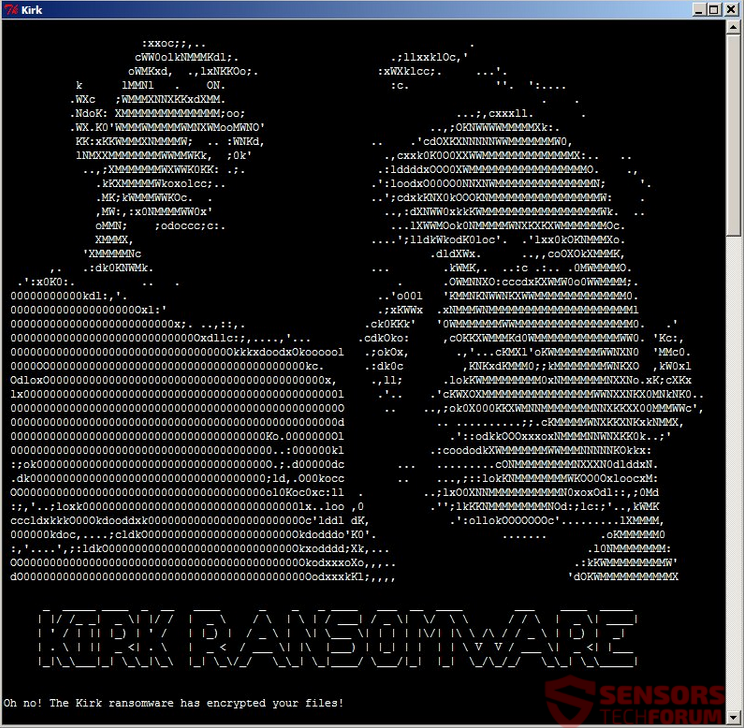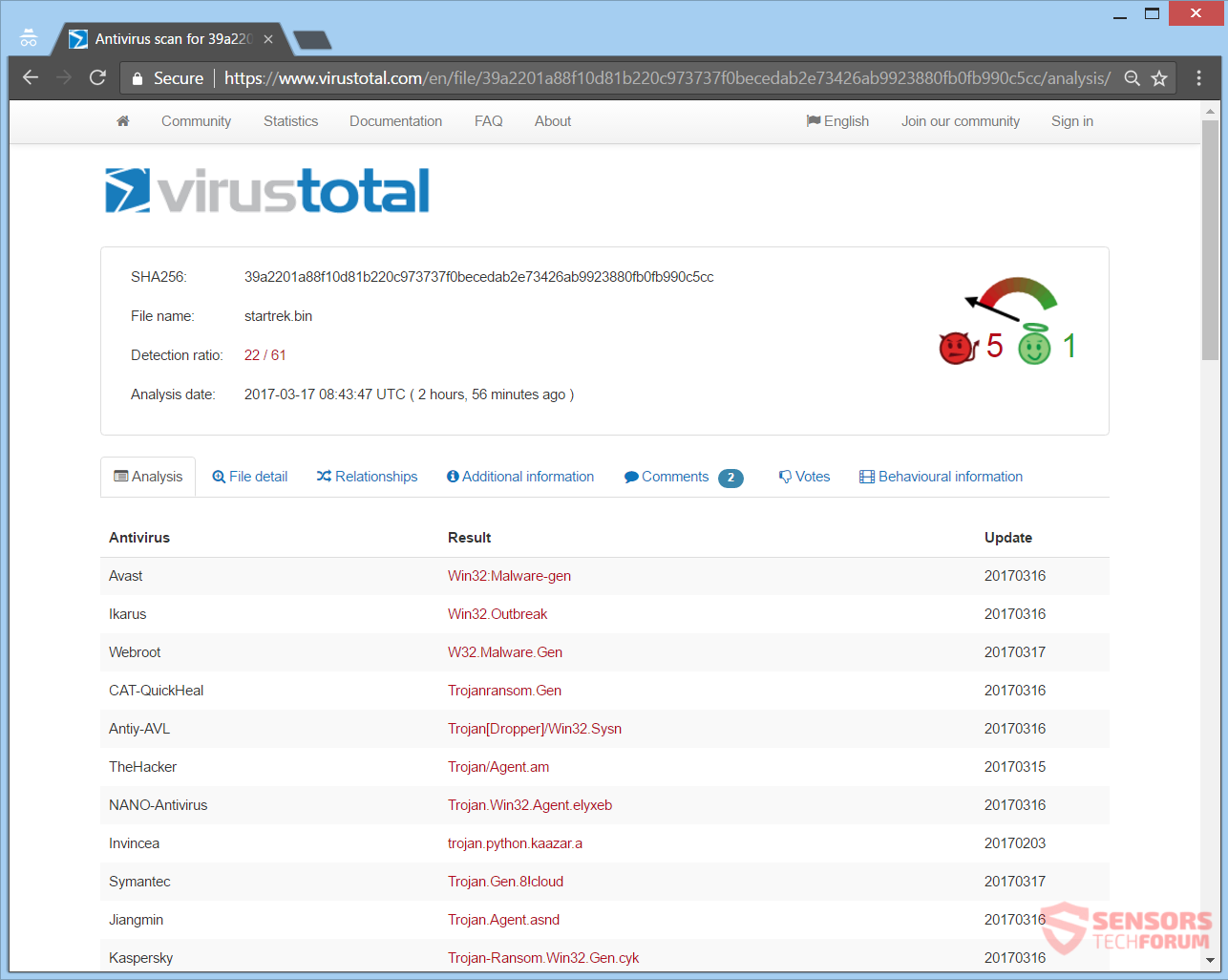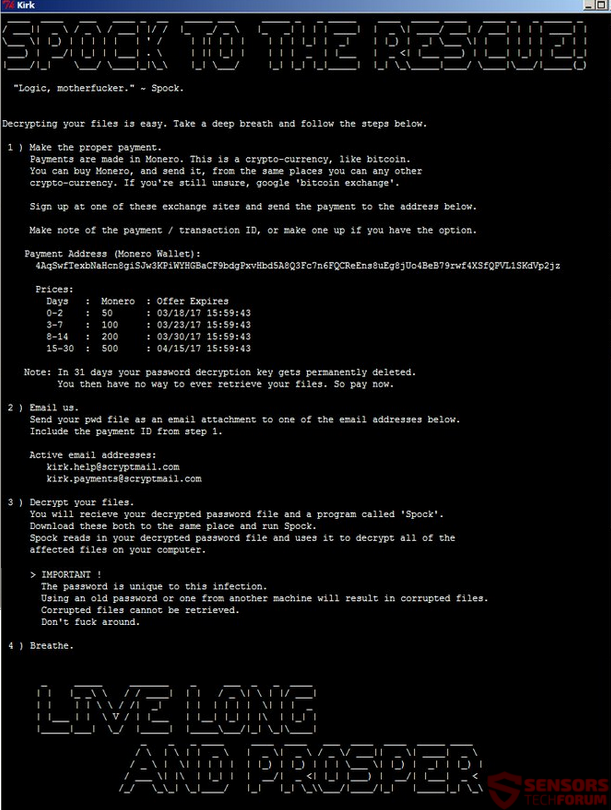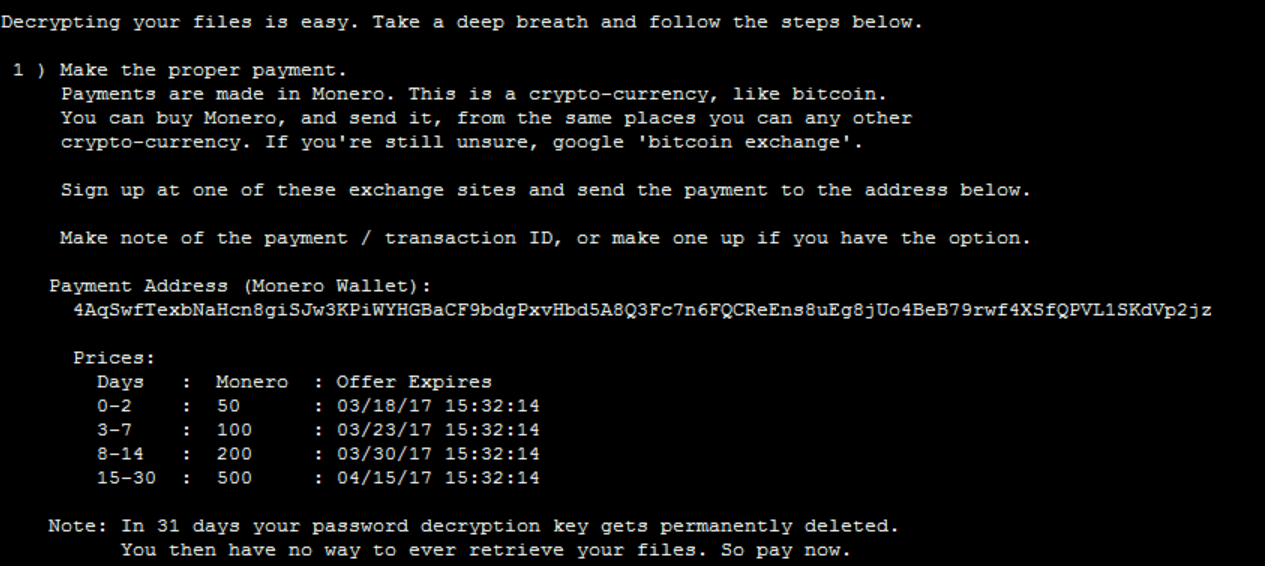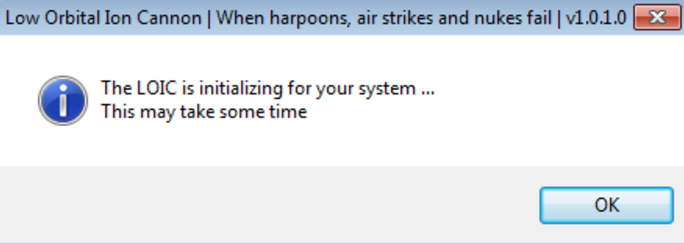This article will help you remove Kirk ransomware effectively. Follow the ransomware removal instructions at the bottom of the article.
Kirk is now the name of a ransomware cryptovirus and not only the name of the emblematic character from the Star Trek franchise. The virus is written in Python and it is the first one that demands payment in the Monero cryptocurrency. AES and RSA are the two encryption algorithms used by the Kirk ransomware to encrypt your files. The ransom note has ANSI elements and is very detailed in its instructions for payment. Keep on reading below to see how you could try to potentially restore some of your data.

Threat Summary
| Name | Kirk |
| Type | Ransomware |
| Short Description | The ransomware encrypts files on your computer and demands payment for unlocking them. |
| Symptoms | The ransomware will encrypt your files while placing the extension .kirked after it completes its encryption process. |
| Distribution Method | Spam Emails, Email Attachments |
| Detection Tool |
See If Your System Has Been Affected by malware
Download
Malware Removal Tool
|
User Experience | Join Our Forum to Discuss Kirk. |
| Data Recovery Tool | Windows Data Recovery by Stellar Phoenix Notice! This product scans your drive sectors to recover lost files and it may not recover 100% of the encrypted files, but only few of them, depending on the situation and whether or not you have reformatted your drive. |

Kirk Ransomware – Infection
Kirk ransomware could spread its infection via different methods. The payload file that initiates the malicious script for this ransomware, which in turn infects your computer machine, is circling the Internet and a malware sample has been found by malware researchers. You can see the VirusTotal detections for different security programs of that sample by checking the screenshot below:
Kirk ransomware could also deliver its payload file on social media websites and networks for file-sharing. Freeware that is found on the Web could be presented as useful but at the same time could hide the malicious script for the cryptovirus. Refrain from opening files just as you have downloaded them, especially if they come from suspicious sources such as links or e-mails. Instead, you should scan them beforehand with a security tool, while also checking the size and signatures of these files for anything that seems out of the ordinary. You should read the ransomware prevention tips from the forum section.

Kirk Ransomware – Details
Kirk ransomware a cryptovirus which is written in the Python programming language. The ransomware gets its name from one of the most iconic characters of the Star Trek franchise – Captain James T. Kirk. Your files will get encrypted with a custom-made extension, that is .kirked, while preserving the original names of files.
Kirk ransomware could make entries in the Windows Registry to achieve persistence, launch and repress processes in Windows. Some entries are designed in a way that will start the virus automatically with each launch of the Windows Operating System, like the example one given right here:
→“HKEY_LOCAL_MACHINE\Software\Microsoft\Windows\CurrentVersion\Run”
The ransom note will be displayed inside a window after the encryption process is complete. That note is very detailed and long and even contains some ANSI images and text based around Star Trek. The note is contained inside a file called RANSOM_NOTE.txt. You can view part of the window of the ransom note message that loads in a window after file encryption completes right down here:
That ransom note reads the following:
Oh no! The Kirk ransomware has encrypted your files!
> ! IMPORTANT ! READ CAREFULLY:Your computer has fallen victim to the Kirk malware and important files have been encrypted – locked up so they don’t work. This may have broken some software, including games, office suites etc. Here’s a list of some the file extensions that were targetted: .3g2 … .pptm .mpk .re4
There are an additional 441 file extensions that are targetted. They are mostly to do with games. To get your files back, you need to pay. Now. Payments recieved more than 48 hours after the time of infection will be charged double. Further time penalties are listed below. The time of infection has been logged. Any files with the extensions listed above will now have the extra extension ‘.kirked’, these files are encrypted using military grade encryption. In the place you ran this program from, you should find a note (named RANSOM_NOTE.txt) similar to this one. You will also find a file named ‘pwd’ – this is your encrypted password file. Although it was generated by your computer, you have no way of ever decrypting it. This is due to the security of both the way it was generated and the way it was encrypted. Your files were encrypted using this password.
“Logic, motherfucker.” ~ Spock. Decrypting your files is easy. Take a deep breath and follow the steps below.
1 ) Make the proper payment. Payments are made in Monero. This is a crypto-currency, like bitcoin. You can buy Monero, and send it, from the same places you can any other crypto-currency. If you’re still unsure, google ‘bitcoin exchange’. Sign up at one of these exchange sites and send the payment to the address below. Make note of the payment / transaction ID, or make one up if you have the option. Payment Address (Monero Wallet): 4AqSwfTexbNaHcn8giSJw3KPiWYHGBaCF9bdgPxvHbd5A8Q3Fc7n6FQCReEns8uEg8jUo4BeB79rwf4XSfQPVL1SKdVp2jz
Prices: Days : Monero : Offer Expires 0-2 : 50 : 03/18/17 15:32:14 3-7 : 100 : 03/23/17 15:32:14 8-14 : 200 : 03/30/17 15:32:14 15-30 : 500 : 04/15/17 15:32:14 Note: In 31 days your password decryption key gets permanently deleted. You then have no way to ever retrieve your files. So pay now.
2 ) Email us. Send your pwd file as an email attachment to one of the email addresses below. Include the payment ID from step 1. Active email addresses: kirk.help@scryptmail.com kirk.payments@scryptmail.com
3 ) Decrypt your files. You will recieve your decrypted password file and a program called ‘Spock’. Download these both to the same place and run Spock. Spock reads in your decrypted password file and uses it to decrypt all of the affected files on your computer. > IMPORTANT ! The password is unique to this infection. Using an old password or one from another machine will result in corrupted files. Corrupted files cannot be retrieved. Don’t fuck around.
4 ) Breathe.
Beneath this sentence you will see an image with the part that introduces the Monero cryptocurrency for the first time as a payment method, and the only available payment method at that:
The note of the Kirk ransomware states that your files are encrypted and to get them back you have to pay in Monero. You should NOT in any circumstance pay these cybercriminals. Your files may not get restored, and nobody could give you a guarantee for that. Furthermore, giving money to these criminals will likely motivate them to create more ransomware or do other criminal activities.
Kirk Ransomware – Encryption Process
The whole encryption process begins with the following notification pop-up:
The text from the notification has the same title as the network stress tool “LOIC”, which is:
Low Orbital Ion Cannon | When harpoons, air strikes and nukes fail | v1.0.1.0
After that message your computer system will be inspected and all files with extensions that the Kirk ransomware seeks to encrypt will become encrypted. That will happen with the help of the AES and RSA encryption algorithms.
Files that have extensions from the following list (around 625 different extensions) will become locked:
→.cfr, .ytd, .sngw, .tst, .skudef, .dem, .sims3pack, .hbr, .hkx, .rgt, .ggpk, .ttarch2, .hogg, .spv, .bm2, .lua, .dff, .save, .rgssad, .scm, .aud, .rxdata, .mcmeta, .bin, .mpqe, .rez, .xbe, .grle, .bf, .iwd, .vpp_pc, .scb, .naz, .m2, .xpk, .sabs, .nfs13save, .gro, .emi, .wad, .15, .vfs, .drs, .taf, .m4s, .player, .umv, .sgm, .ntl, .esm, .qvm, .arch00, .tir, .bk, .sabl, .bin, .opk, .vfs0, .xp3, .tobj, .rcf, .sga, .esf, .rpack, .DayZProfile, .qsv, .gam, .bndl, .u2car, .psk, .gob, .lrf, .lts, .iqm, .i3d, .acm, .SC2Replay, .xfbin, .db0, .fsh, .dsb, .cry, .osr, .gcv, .blk, .4, .lzc, .umod, .w3x, .mwm, .crf, .tad, .pbn, .14, .ppe, .ydc, .fmf, .swe, .nfs11save, .tgx, .trf, .atlas, .20, .game, .rw, .rvproj2, .sc1, .ed, .lsd, .pkz, .rim, .bff, .gct, .9, .fpk, .pk3, .osf, .bns, .cas, .lfl, .rbz, .sex, .mrm, .mca, .hsv, .vpt, .pff, .i3chr, .tor, .01, .utx, .kf, .dzip, .fxcb, .modpak, .ydr, .frd, .bmd, .vpp, .gcm, .frw, .baf, .edf, .w3g, .mtf, .tfc, .lpr, .pk2, .cs2, .fps, .osz, .lnc, .jpz, .tinyid, .ebm, .i3exec, .ert, .sv4, .cbf, .oppc, .enc, .rmv, .mta, .otd, .pk7, .gm, .cdp, .cmg, .ubi, .hpk, .plr, .mis, .ids, .replay_last_battle, .z2f, .map, .ut4mod, .dm_1, .p3d, .tre, .package, .streamed, .l2r, .xbf, .wep, .evd, .dxt, .bba, .profile, .vmt, .rpf, .ucs, .lab, .cow, .ibf, .tew, .bix, .uhtm, .txd, .jam, .ugd, .13, .dc6, .vdk, .bar, .cvm, .wso, .xxx, .zar, .anm, .6, .ant, .ctp, .sv5, .dnf, .he0, .mve, .emz, .e4mod, .gxt, .bag, .arz, .tbi, .itp, .i3animpack, .vtf, .afl, .ncs, .gaf, .ccw, .tsr, .bank, .lec, .pk4, .psv, .los, .civ5save, .rlv, .nh, .sco, .ims, .epc, .rgm, .res, .wld, .sve, .db1, .dazip, .vcm, .rvm, .eur, .me2headmorph, .azp, .ags, .12, .slh, .cha, .wowsreplay, .dor, .ibi, .bnd, .zse, .ddsx, .mcworld, .intr, .vdf, .mtr, .addr, .blp, .mlx, .d2i, .21, .tlk, .gm1, .n2pk, .ekx, .tas, .rav, .ttg, .spawn, .osu, .oac, .bod, .dcz, .mgx, .wowpreplay, .fuk, .kto, .fda, .vob, .ahc, .rrs, .ala, .mao, .udk, .jit, .25, .swar, .nav, .bot, .jdf, .32, .mul, .szs, .gax, .xmg, .udm, .zdk, .dcc, .blb, .wxd, .isb, .pt2, .utc, .card, .lug, .JQ3SaveGame, .osk, .nut, .unity, .cme, .elu, .db7, .hlk, .ds1, .wx, .bsm, .w3z, .itm, .clz, .zfs, .3do, .pac, .dbi, .alo, .gla, .yrm, .fomod, .ees, .erp, .dl, .bmd, .pud, .ibt, .24, .wai, .sww, .opq, .gtf, .bnt, .ngn, .tit, .wf, .bnk, .ttz, .nif, .ghb, .la0, .bun, .11, .icd, .z3, .djs, .mog, .2da, .imc, .sgh, .db9, .42, .vis, .whd, .pcc, .43, .ldw, .age3yrec, .pcpack, .ddt, .cok, .xcr, .bsp, .yaf, .swd, .tfil, .lsd, .blorb, .unr, .mob, .fos, .cem, .material, .lfd, .hmi, .md4, .dog, .256, .eix, .oob, .cpx, .cdata, .hak, .phz, .stormreplay, .lrn, .spidersolitairesave-ms, .anm, .til, .lta, .sims2pack, .md2, .pkx, .sns, .pat, .tdf, .cm, .mine, .rbn, .uc, .asg, .raf, .myp, .mys, .tex, .cpn, .flmod, .model, .sfar, .fbrb, .sav2, .lmg, .tbc, .xpd, .bundledmesh, .bmg, .18, .gsc, .shader_bundle, .drl, .world, .rwd, .rwv, .rda, .3g2, .3gp, .asf, .asx, .avi, .flv, .ai, .m2ts, .mkv, .mov, .mp4, .mpg, .mpeg, .mpeg4, .rm, .swf, .vob, .wmv, .doc, .docx, .pdf, .rar, .jpg, .jpeg, .png, .tiff, .zip, .7z, .dif.z, .exe, .tar.gz, .tar, .mp3, .sh, .c, .cpp, .h, .mov, .gif, .txt, .py, .pyc, .jar, .csv, .psd, .wav, .ogg, .wma, .aif, .mpa, .wpl, .arj, .deb, .pkg, .db, .dbf, .sav, .xml, .html, .aiml, .apk, .bat, .bin, .cgi, .pl, .com, .wsf, .bmp, .bmp, .gif, .tif, .tiff, .htm, .js, .jsp, .php, .xhtml, .cfm, .rss, .key, .odp, .pps, .ppt, .pptx, .class, .cd, .java, .swift, .vb, .ods, .xlr, .xls, .xlsx, .dot, .docm, .dotx, .dotm, .wpd, .wps, .rtf, .sdw, .sgl, .vor, .uot, .uof, .jtd, .jtt, .hwp, .602, .pdb, .psw, .xlw, .xlt, .xlsm, .xltx, .xltm, .xlsb, .wk1, .wks, .123, .sdc, .slk, .pxl, .wb2, .pot, .pptm, .potx, .potm, .sda, .sdd, .sdp, .cgm, .wotreplay, .rofl, .pak, .big, .bik, .xtbl, .unity3d, .capx, .ttarch, .iwi, .rgss3a, .gblorb, .xwm, .j2e, .mpk, .xex, .tiger, .lbf, .cab, .rx3, .epk, .vol, .asset, .forge, .lng, .sii, .litemod, .vef, .dat, .papa, .psark, .ydk, .mpq, .wtf, .bsa, .re4, .dds, .ff, .yrp, .pck, .t3, .ltx, .uasset, .bikey, .patch, .upk, .uax, .mdl, .lvl, .qst, .ddv, .pta
Extension list source: Bleeping Computer
When observing that list is revealed that many extensions belong to files of computer games and their “saves”. Each file that gets encrypted will receive the same extension appended after its original extension. The second extension after the original one will be .kirked.
In the ransom note, there is a section mentioning a Spock decryption tool, that you have to pay for if you want your files returned to normal. For the moment, there is no other information about decryption other than malware researchers saying that it doesn’t seem possible yet.
However, if you want to have any chance of decryption in the future, you should keep a file called pwd that is found under the same directory as the file loic_win32.exe, which is the ransomware executable file.
The Kirk cryptovirus is not excluded to delete the Shadow Volume Copies from the Windows operating system by utilizing the following command:
→vssadmin.exe delete shadows /all /Quiet
Although, that is highly unlikely, as its main target probably isn’t the Windows OS to begin with.
Read on through and check out what type of ways you can try to potentially restore some of your data.

Remove Kirk Ransomware and Restore .Kirked Files
If your computer got infected with the Kirk ransomware virus, you should have a bit of experience in removing malware. You should get rid of this ransomware as quickly as possible before it can have the chance to spread further and infect other computers. You should remove the ransomware and follow the step-by-step instructions guide provided below.
- Step 1
- Step 2
- Step 3
- Step 4
- Step 5
Step 1: Scan for Kirk with SpyHunter Anti-Malware Tool



Ransomware Automatic Removal - Video Guide
Step 2: Uninstall Kirk and related malware from Windows
Here is a method in few easy steps that should be able to uninstall most programs. No matter if you are using Windows 10, 8, 7, Vista or XP, those steps will get the job done. Dragging the program or its folder to the recycle bin can be a very bad decision. If you do that, bits and pieces of the program are left behind, and that can lead to unstable work of your PC, errors with the file type associations and other unpleasant activities. The proper way to get a program off your computer is to Uninstall it. To do that:


 Follow the instructions above and you will successfully delete most unwanted and malicious programs.
Follow the instructions above and you will successfully delete most unwanted and malicious programs.
Step 3: Clean any registries, created by Kirk on your computer.
The usually targeted registries of Windows machines are the following:
- HKEY_LOCAL_MACHINE\Software\Microsoft\Windows\CurrentVersion\Run
- HKEY_CURRENT_USER\Software\Microsoft\Windows\CurrentVersion\Run
- HKEY_LOCAL_MACHINE\Software\Microsoft\Windows\CurrentVersion\RunOnce
- HKEY_CURRENT_USER\Software\Microsoft\Windows\CurrentVersion\RunOnce
You can access them by opening the Windows registry editor and deleting any values, created by Kirk there. This can happen by following the steps underneath:


 Tip: To find a virus-created value, you can right-click on it and click "Modify" to see which file it is set to run. If this is the virus file location, remove the value.
Tip: To find a virus-created value, you can right-click on it and click "Modify" to see which file it is set to run. If this is the virus file location, remove the value.
Before starting "Step 4", please boot back into Normal mode, in case you are currently in Safe Mode.
This will enable you to install and use SpyHunter 5 successfully.
Step 4: Boot Your PC In Safe Mode to isolate and remove Kirk





Step 5: Try to Restore Files Encrypted by Kirk.
Method 1: Use STOP Decrypter by Emsisoft.
Not all variants of this ransomware can be decrypted for free, but we have added the decryptor used by researchers that is often updated with the variants which become eventually decrypted. You can try and decrypt your files using the instructions below, but if they do not work, then unfortunately your variant of the ransomware virus is not decryptable.
Follow the instructions below to use the Emsisoft decrypter and decrypt your files for free. You can download the Emsisoft decryption tool linked here and then follow the steps provided below:
1 Right-click on the decrypter and click on Run as Administrator as shown below:

2. Agree with the license terms:

3. Click on "Add Folder" and then add the folders where you want files decrypted as shown underneath:

4. Click on "Decrypt" and wait for your files to be decoded.

Note: Credit for the decryptor goes to Emsisoft researchers who have made the breakthrough with this virus.
Method 2: Use data recovery software
Ransomware infections and Kirk aim to encrypt your files using an encryption algorithm which may be very difficult to decrypt. This is why we have suggested a data recovery method that may help you go around direct decryption and try to restore your files. Bear in mind that this method may not be 100% effective but may also help you a little or a lot in different situations.
Simply click on the link and on the website menus on the top, choose Data Recovery - Data Recovery Wizard for Windows or Mac (depending on your OS), and then download and run the tool.
Kirk-FAQ
What is Kirk Ransomware?
Kirk is a ransomware infection - the malicious software that enters your computer silently and blocks either access to the computer itself or encrypt your files.
Many ransomware viruses use sophisticated encryption algorithms to make your files inaccessible. The goal of ransomware infections is to demand that you pay a ransom payment to get access to your files back.
What Does Kirk Ransomware Do?
Ransomware in general is a malicious software that is designed to block access to your computer or files until a ransom is paid.
Ransomware viruses can also damage your system, corrupt data and delete files, resulting in the permanent loss of important files.
How Does Kirk Infect?
Via several ways.Kirk Ransomware infects computers by being sent via phishing emails, containing virus attachment. This attachment is usually masked as an important document, like an invoice, bank document or even a plane ticket and it looks very convincing to users.
Another way you may become a victim of Kirk is if you download a fake installer, crack or patch from a low reputation website or if you click on a virus link. Many users report getting a ransomware infection by downloading torrents.
How to Open .Kirk files?
You can't without a decryptor. At this point, the .Kirk files are encrypted. You can only open them once they are decrypted using a specific decryption key for the particular algorithm.
What to Do If a Decryptor Does Not Work?
Do not panic, and backup the files. If a decryptor did not decrypt your .Kirk files successfully, then do not despair, because this virus is still new.
Can I Restore ".Kirk" Files?
Yes, sometimes files can be restored. We have suggested several file recovery methods that could work if you want to restore .Kirk files.
These methods are in no way 100% guaranteed that you will be able to get your files back. But if you have a backup, your chances of success are much greater.
How To Get Rid of Kirk Virus?
The safest way and the most efficient one for the removal of this ransomware infection is the use a professional anti-malware program.
It will scan for and locate Kirk ransomware and then remove it without causing any additional harm to your important .Kirk files.
Can I Report Ransomware to Authorities?
In case your computer got infected with a ransomware infection, you can report it to the local Police departments. It can help authorities worldwide track and determine the perpetrators behind the virus that has infected your computer.
Below, we have prepared a list with government websites, where you can file a report in case you are a victim of a cybercrime:
Cyber-security authorities, responsible for handling ransomware attack reports in different regions all over the world:
Germany - Offizielles Portal der deutschen Polizei
United States - IC3 Internet Crime Complaint Centre
United Kingdom - Action Fraud Police
France - Ministère de l'Intérieur
Italy - Polizia Di Stato
Spain - Policía Nacional
Netherlands - Politie
Poland - Policja
Portugal - Polícia Judiciária
Greece - Cyber Crime Unit (Hellenic Police)
India - Mumbai Police - CyberCrime Investigation Cell
Australia - Australian High Tech Crime Center
Reports may be responded to in different timeframes, depending on your local authorities.
Can You Stop Ransomware from Encrypting Your Files?
Yes, you can prevent ransomware. The best way to do this is to ensure your computer system is updated with the latest security patches, use a reputable anti-malware program and firewall, backup your important files frequently, and avoid clicking on malicious links or downloading unknown files.
Can Kirk Ransomware Steal Your Data?
Yes, in most cases ransomware will steal your information. It is a form of malware that steals data from a user's computer, encrypts it, and then demands a ransom in order to decrypt it.
In many cases, the malware authors or attackers will threaten to delete the data or publish it online unless the ransom is paid.
Can Ransomware Infect WiFi?
Yes, ransomware can infect WiFi networks, as malicious actors can use it to gain control of the network, steal confidential data, and lock out users. If a ransomware attack is successful, it could lead to a loss of service and/or data, and in some cases, financial losses.
Should I Pay Ransomware?
No, you should not pay ransomware extortionists. Paying them only encourages criminals and does not guarantee that the files or data will be restored. The better approach is to have a secure backup of important data and be vigilant about security in the first place.
What Happens If I Don't Pay Ransom?
If you don't pay the ransom, the hackers may still have access to your computer, data, or files and may continue to threaten to expose or delete them, or even use them to commit cybercrimes. In some cases, they may even continue to demand additional ransom payments.
Can a Ransomware Attack Be Detected?
Yes, ransomware can be detected. Anti-malware software and other advanced security tools can detect ransomware and alert the user when it is present on a machine.
It is important to stay up-to-date on the latest security measures and to keep security software updated to ensure ransomware can be detected and prevented.
Do Ransomware Criminals Get Caught?
Yes, ransomware criminals do get caught. Law enforcement agencies, such as the FBI, Interpol and others have been successful in tracking down and prosecuting ransomware criminals in the US and other countries. As ransomware threats continue to increase, so does the enforcement activity.
About the Kirk Research
The content we publish on SensorsTechForum.com, this Kirk how-to removal guide included, is the outcome of extensive research, hard work and our team’s devotion to help you remove the specific malware and restore your encrypted files.
How did we conduct the research on this ransomware?
Our research is based on an independent investigation. We are in contact with independent security researchers, and as such, we receive daily updates on the latest malware and ransomware definitions.
Furthermore, the research behind the Kirk ransomware threat is backed with VirusTotal and the NoMoreRansom project.
To better understand the ransomware threat, please refer to the following articles which provide knowledgeable details.
As a site that has been dedicated to providing free removal instructions for ransomware and malware since 2014, SensorsTechForum’s recommendation is to only pay attention to trustworthy sources.
How to recognize trustworthy sources:
- Always check "About Us" web page.
- Profile of the content creator.
- Make sure that real people are behind the site and not fake names and profiles.
- Verify Facebook, LinkedIn and Twitter personal profiles.


